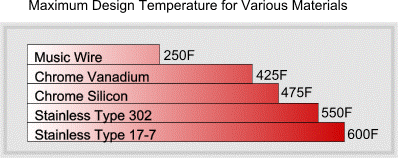Spring Training
The proper design of compression, extension and Torsion Springs requires a knowledge of both the potentials and limitations of available materials, together with simple formulas. Since spring theory is normally developed on the basis of spring rate (or gradient), the formula for spring rate is the most widely used in spring design.
The design formula for the different types of springs are presented in their own sections. Materials and physical properties that are common to all spring configurations are shown here.
Material
There are four common types of materials used in spring manufacturing:
- Music Wire is the most common and inexpensive spring material. They provide uniform tensile strength for a high quality spring. Music Wire can be used in applications up to 250° F or 121° Celsius.
- Chrome Vanadium is cold drawn and heat treated. Used for shock loads and slightly elevated temperatures to 425° F or 219° Celsius.
- Chrome Silicon with similar properties to Chrome Vanadium can withstand temperatures up to 475° F or 246° Celsius.
- Stainless Steel Type 302 Provides a more durable spring ideal for harsh environmental conditions where corrosion and high temperatures are expected. These spring are not as strong as those made from Music Wire. When using this stainless, multiply rate and load by 0.833. Stainless springs are recommended for applications up to 500° F or 260° Celsius.
- Stainless Steel Type 17-7 is a high strength and provides general purpose corrosion resistance. Precipitation hardening after fabrication provides similar strength to music wire. The design temperature for this material should not exceed 650° F or 343° Celsius.

Engineering Properties
For the Engineers that would like to calculate spring rates, loads and deflections the following table provides the required design parameters.
| Material | Minimum Tensile Strength (psi x 103) | Modulus of Elasticity (psi x 106) | Design Stress % of Minimum Tensile Strength | Modulus in Torsion G (psi x 106) | Rockwell Hardness |
|---|---|---|---|---|---|
| Music Wire ASTM A 228 | 230 - 299 | 30 | 45 | 11.5 | C41 -60 |
| Chrome Vanadium ASTM A 230 | 190 - 300 | 30 | 45 | 11.5 | C41 - 55 |
| Chrome Silicon ASTM A 401 | 235 - 300 | 30 | 45 | 11.5 | C48 - 55 |
| Stainless Type 302 ASTM A 313 | 125 - 325 | 28 | 30 - 40 | 10 | C35 - 45 |
| Stainless Type 17-7 ASTM A 313 (631) | 235 - 335 | 29.5 | 45 | 11 | C38 - 57 |
Finishes
The standard finish is that of the normal spring material. Shot-peened and plated finishes can be applied.
Design Considerations
Spring Selection
Compression Springs are normally located by searching for the dimensions that fit your application. The wire size, and as a result the spring rate, is varied to obtain the necessary design load. Search the Compression Spring Database.
Extension Springs are located based on the dimension required for a given application. The various wire sizes, and corresponding spring rates are then checked to obtain the necessary load. Search the Extension Spring Database.
Torsion Springs can be selected based on the overall dimensions required for the application. The torque values can be increased by 20% for static loading applications. Infinite fatigue life can be expected using deflection values about 40% less than those listed. Search the Torsion Spring Database.
Disc Springs can be selected in the Series 30 for Belleville type-bolting applications or series 31 manufactured to metric dimensions. The Series 34 may be installed between two ball bearings to provide precise bearing preload and proper tension. The Series 35 is a precision manufactured in imperial units. Search the Disc Spring Database.
Die Springs are available in 600 standard sizes in five distinct pressure groups. They follow the familiar red, gold and green colors as defined by Raymond ® and trademarked by Barnes Group Inc. Search the Die Spring Database.
Constant Force Springs are produced to provide a specific force which is extended through the entire extension of the spring. They can be used in applicatiosn required constant force or constant torque. Search the Constant Force Spring Database.
Square Wire Springs are used for applications requiring high initial pressure and mostly for short run applications. Socked in 12" lengths only, these springs can be cut to any desired length. Search the Square Wire Spring Database.
Warning: All springs are energy absorbing devices with a definite life cycle. They should be used with care and should not be used where failure would be hazardous.